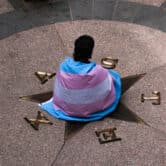BURLINGTON, Vt. (CN) — The Vermont Law School can cover up murals that it believes are racially insensitive even though the artist objects, the Second Circuit held Friday in a case that pitted artistic freedom against the post-George Floyd effort to rectify images of the past that no longer reflect contemporary social attitudes.
Although a 1990 federal law protects artists against having their works modified or destroyed, the law “does not mandate the preservation of art at all costs and without due regard for the rights of others,” U.S. Circuit Chief Judge Debra Livingston wrote in a unanimous 39-page opinion.
At issue are two 8-by-24-foot murals painted in 1993 by artist Samuel Kerson, who is white, depicting the history of slavery and of the Underground Railroad in Vermont. Although the murals were initially praised, by 2001 they began drawing criticism for their images of black people.
According to the ruling, the art was derided as “depicting enslaved African people in a cartoonish, almost animalistic style” with “large lips, startled eyes, big hips and muscles eerily similar to ‘Sambos’ or other racist … caricatures.”
Matters came to a head after the 2020 George Floyd protests, when more than 100 students, alumni, faculty and staff signed a petition asking to have the murals removed.
Kerson objected and claimed that removing the murals would violate the Visual Artists Rights Act of 1990, which prohibits the “destruction … distortion, mutilation, or other modification” of certain artworks without the artist’s permission.
Because the murals were painted directly on the walls of the school’s community center, the school determined that it couldn’t move them without destroying them, so it proposed instead erecting a wall of opaque acoustic panels two inches in front of them that would permanently remove them from view.
Kerson sued, but the Second Circuit sided with the law school, reading the statute literally and finding that blocking anyone from seeing the murals doesn't “destroy” or “modify” them.
“There is no dispute that after the acoustic panels were affixed to the wall of the Chase Community Center, the murals remained fully intact,” Livingston wrote.
“Indeed, the wall was designed so as to not touch the murals and thus did not physically alter them whatsoever, let alone ruin them or render them unrepairable. Thus, [the law school] plainly did not destroy the murals by erecting a barrier shielding them from view.”
Livingston also held that, under the law, “modification … does not encompass merely concealing an artwork from view in a manner that does not otherwise alter the work.”
“In the context of a work of art,” she wrote, “‘modifications’ clearly include certain alterations to the work itself, such as an additional brush stroke, erasure of content, or reorganization of a movable component. Modification, as conventionally understood, does not include concealing a work of art behind a solid barrier, assuming the work remains intact while hidden from view.”
The 1990 law applies only to works created after its passage, so the ruling will have no effect on Confederate statues and other antique monuments. But there is no shortage of controversy over more contemporary works.
Just last year in Georgetown, Texas, for instance, a mural painted by high school students on the side of a building in the town square generated protests because it promotes LGBTQ rights. Similar issues were raised in Grant, Michigan, over a mural on the wall of a middle school health center.
A tattoo parlor in Midvale, Utah, was also criticized last year for an outdoor mural that some said contained erotic content.
In 2018, Dartmouth College removed a 1930s mural showing drunken Native Americans being swindled out of their land rights. Similar criticism has been brought to bear against other Depression-era murals, including one at a Chicago school administration building showing Native Americans serving a white man and one at a San Francisco high school depicting George Washington next to black slaves and a dead Native American.
Subscribe to Closing Arguments
Sign up for new weekly newsletter Closing Arguments to get the latest about ongoing trials, major litigation and hot cases and rulings in courthouses around the U.S. and the world.









